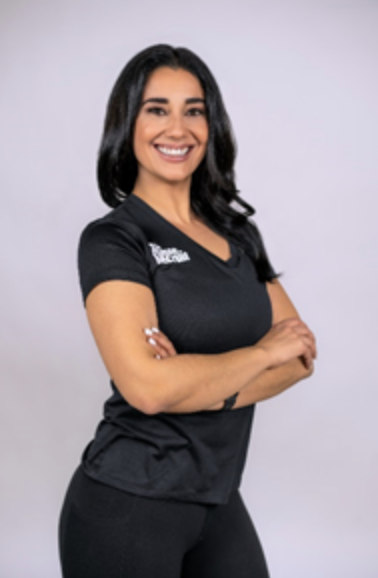PREGGERCIZE: www.thegluterecruit.com
Pregnancy comes with its share of unwanted physical side effects. Provided it’s ok with your physician, chances are good that increasing your level of exercise, will ease the negative side effects of being pregnant and fight pregnancy fatigue. Low-level tiredness plagues many women during the first trimester, then again late in the third trimester. It seems paradoxical, but sometimes getting too much rest can actually make you feel more exhausted. And while you should never push yourself too hard when you’re pregnant, a little nudge can make a big difference in your pregnancy energy level. So take baby steps. You’ll be surprised at how peppy you feel afterward!
Jessica Mazzucco is a certified fitness trainer in NYC who trains many pregnant women.
She shares a Pre- Natal Routine to be performed two times per week and alternated with some cardio. She advises women to get medical clearance from their OB/GYN before engaging in any type of exercise.
EXERCISE 1– One Arm Dumbbell Row (back and arms)
Place one hand and one knee on a utility bench; with the torso almost horizontal, maintain a flat back in a neutral spine position. With the hand that is not on the bench, grip the dumbbell using an overhand grip (with the thumb wrapped around the dumbbell) and extend the arm to the side. To initiate movement, bend arm at elbow and shoulder to pull the dumbbell upward until it reaches the torso. Extend the arm, following the same path used for the upward movement, performing the full range of motion. Do 2 sets of 15 reps each, rest 20-30 seconds in between.
EXERCISE 2 – Knee Push Ups (chest, arms and shoulders)
Come to a hands and knees position (quadruped) on the mat with your hands directly under your shoulders; fingers facing forward and knees under your hips. Engage the abdominals and pull the shoulder blades down your back. Reposition your knees as needed to create a straight line in your body from the knees, through the torso and out through the head. There should be no bend at the hips. Keeping the torso rigid and head aligned with your spine, slowly bend your elbows and lower your body toward the floor. Your elbows should remain close to the sides of your body or flare outwards slightly. Maintaining a rigid torso and head aligned with your spine, press upward through your arms. Do 2 sets of 10-15 reps, rest 20-30 seconds in between.
EXERCISE 3 – Bodyweight Squats (legs, butt, hips and core)
Begin standing with your feet slightly wider than hip-width and your toes turned out slightly. Your hands are by your sides with your palms facing inward. Keeping your back flat, hinge at your hips and shift them back and down. Your hips and knees bend simultaneously. Continue to lower yourself until your thighs are parallel or almost parallel to the floor. While maintaining the position of your back, chest and head and with the abdominals engaged, exhale and return to start position by pushing your feet into the floor through your heels. Do 2 sets of 15 reps each, rest 20-30 seconds in between.
EXERCISE 4 – Dumbbell Reverse Lunge (legs, butt, hips)
Stand with the feet shoulder-width apart, and hold a dumbbell at each side. Keeping the torso vertical, take a large step backward. Once the rear foot makes contact with the ground, move downward so that the knee of the rear leg is just above the floor. Ensure that the front knee does not move beyond the toes of the front foot. For each repetition, return to the starting position by following the same path used for the downward movement. Do 2 sets of 15 reps at each side, rest 20-30 seconds in between.
EXERCISE 5 – Side Plank (obliques)
While lying on your side bend one elbow to about 90 degrees and rise off the floor. Keep the spine neutral and align the head with the torso. Hold the position for 20 seconds and repeat 2 times on each side.
Jessica Mazzucco is an NYC area certified fitness trainer and founder of The Glute Recruit® A native New Yorker, she graduated from SUNY Plattsburgh with a Bachelor’s Degree in Psychology and a Master’s Degree in Social Work from Adelphi University. The latter enables her to use skills of therapeutic communication and client centeredness to help her clients transition through change. Jessica has over 7 years of experience in the fitness industry and a multitude of diverse fitness certifications including :
World Instructor Training Schools (WITS) Personal Training Certification
National Posture Institute (NPI) Certified Posture Specialist + Certified Resistance Training Professional
ViPR – Vitality Performance Reconditioning – Level 1 Trainer
Kettlebell Athletics – Kettlebell Level 1 Trainer
Prenatal/Postnatal
SRT (Soft Release Technique) – Lower Body Fascial Stretch Therapist
Areas of Focus
Her specialties include butt sculpt/lift through exercise, resistance, strength and weight training for women, nutrition, muscle building, flexibility, mobility, posture enhancement, and pre and post-natal workout regimens. Jess has trained celebrities such as former MSNBC Legal Analyst Mimi Rocah and country singer Jessica Lynn.
Her personal journey
Jess has helped women worldwide achieve their fitness and lifestyle goals. She embarked on her own journey toward a healthier lifestyle in 2010 when she realized how unhealthy she was physically due to poor dietary choices and lack of exercise. Her weight gain had led her to develop low self-confidence and poor relationships with food. Healthy dietary changes and slow implementation of exercise helped Jess to become physically healthier and restore her self-esteem. This success gave her the platform to pursue a career in fitness and personal training. Her mission is to educate women on how to take control of their lives and become the healthiest versions of themselves without setting unrealistic goals of an “ideal” body type.








 Jessica Mazzucco founder of
Jessica Mazzucco founder of 
 www.nynjspine.com
www.nynjspine.com



